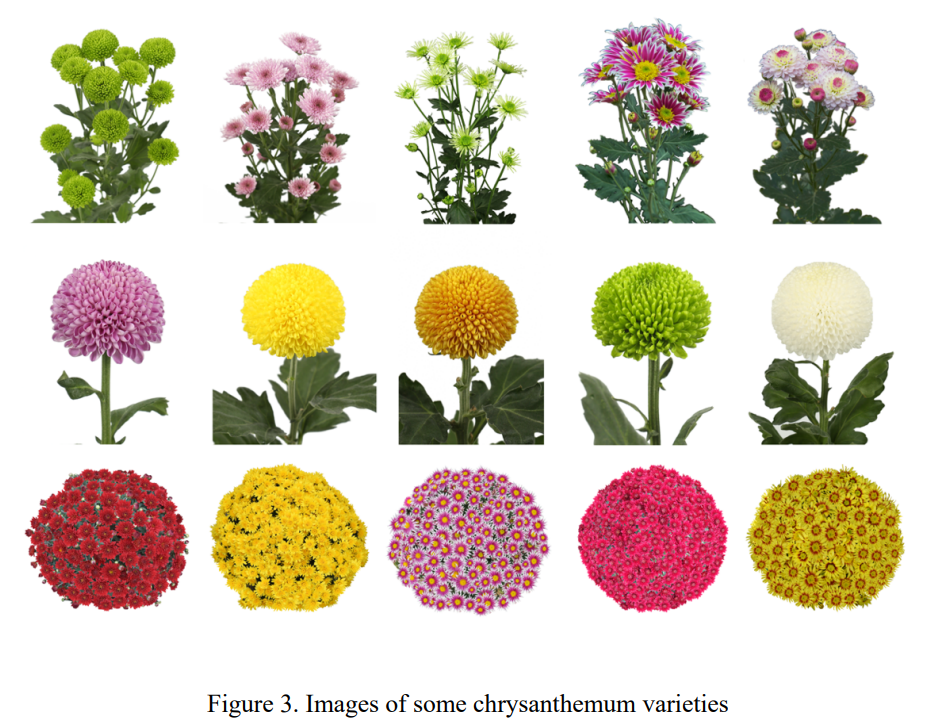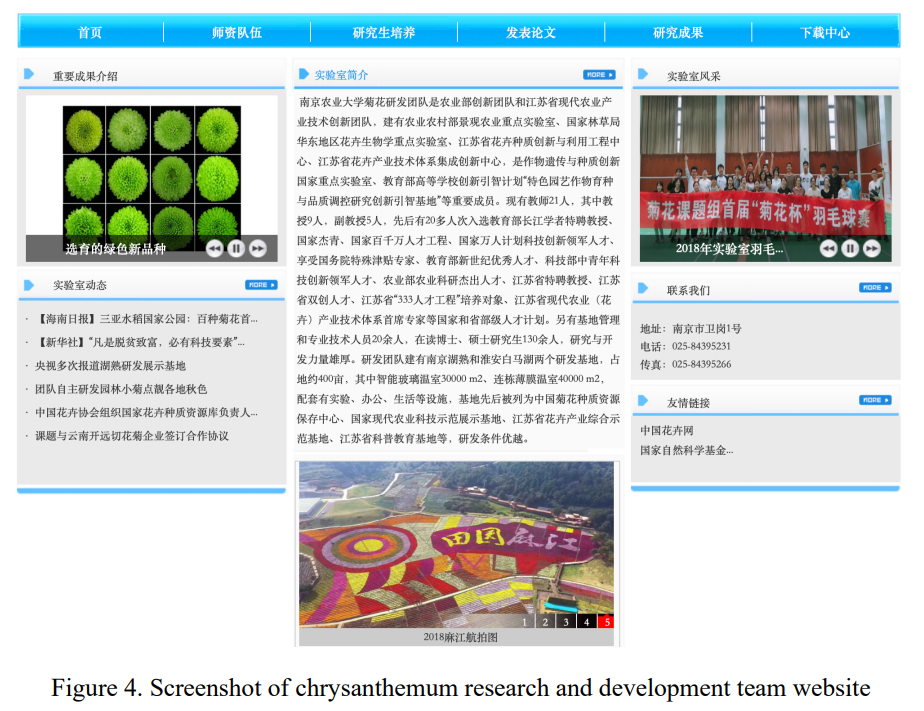The chrysanthemum research and development team of Nanjing Agricultural University is the innovation team of the Ministry of agriculture and the modern agricultural industry technology innovation team of Jiangsu Province. It has established the Key Laboratory of Landscaping, ministry of Agriculture and rural affairs, P.R.China and Key Laboratory of Biology of Ornamental Plants in East China, National Forestry and Grassland Administration. And it is also an important member of the State Key Laboratory of Crop Genetics and Germplasm Enhancement, P.R.China.
At present, there are 22 teachers, including 9 professors and 5 associate professors. In addition, there are more than 20 base management and professional and technical personnel, more than 130 doctoral and master's degree students, and strong research and development force. The research and development team has built two main bases, Nanjing Hushu and Huai'an Baimahu, covering an area of about 400 mu, including 30000 m2 of intelligent glass greenhouse and 40000 m2 of multi span film greenhouse, with laboratory, office, living and other facilities. The base has been listed as China chrysanthemum Germplasm Conservation Center. In recent years, the chrysanthemum research and development team has collected and preserved about 5000 chrysanthemum resources, ranking first in the world; More than 400 new varieties of cut chrysanthemum, potted chrysanthemum, garden chrysanthemum, tea chrysanthemum and edible chrysanthemum were selected.

Figure 1. Group photo of teachers and students in chrysanthemum research and development team
Research interests
The team’s main research directions include Chrysanthemum Abiotic and Biotic stresses, Development and Genetics, Germplasm Resources Evaluation and Innovation, Genomics and Bioinformatics, etc.
1. Chrysanthemum Abiotic and Biotic stresses
(1) Waterlogging causes the death and loss of chrysanthemum to a great extent. Ethylene is a key plant hormone involved in the response of chrysanthemum to waterlogging. We are focusing on regulatory roles of key transcription factors modulating the production of ethylene and ethylene signaling upon waterlogging.
(2) Salinity threatens chrysanthemum production. Our primary research interest concerns how heat shock factor confers to the tolerance of chrysanthemum to salinity. An emerging role of heat shock factors in integrating salinity with other stresses has been recognized. Topics that have attracted our attention recently is how heat shock factors integrates ABA and ROS signals in response to salinity.
(3) Aphid infestation is a prominent hazard of chrysanthemum. Lignin, an important component of plant cell wall, acts as a mechanical barrier against the feeding of aphids. Our lab has isolated several members of MYB transcription family and validated their roles in accelerating the synthesis of lignin and resistance of chrysanthemum to aphids. Recently, we are focusing on how MYBs regulate the biosynthesis process of lignin in response to aphids and plant hormones. In addition, terpenes have been well known as a component of volatiles repelling the aphids and attracting predators of aphids. Several kinds of terpenes involved in resistance of chrysanthemum to aphids were identified. We are currently dissecting the key factors regulating terpene biosynthesis pathways in chrysanthemum.
2. Development and Genetics
(1) Flower color: Flower color is one of the most important traits in ornamental plants, and it has also been an important breeding goal in the long history of chrysanthemum breeding. Flavonoids confer a wide range of colors to chrysanthemum flowers. We are interested in molecular networks regulating flavonoid synthesis, mechanisms involved in flower color bud sport mutation in chrysanthemum, and how environmental factors influence flower color formation in chrysanthemum.
(2) Flower development: Chrysanthemum is well-known for showy highly compressed capitulum which is composed of both female ray florets and bisexual disc florets. Chrysanthemum is rich in inflorescence form and petal type, which are the significant embodiment of its ornamental value. However, the molecular mechanism underlying flower and petal shape is still largely unexplored. The weighted gene coexpression network analysis (WGCNA) revealed important networks and hub genes including ray floret petals-specific coexpression network,disc floret petals-specific network, B and E class genes involved network and CYC2 genes network. We are going to focus on these networks in determining petal morphogenesis and ray and disc flowers.
(3) Senescence: Leaf yellowing and early wilting shortens the shelf life and causes decay in the postharvest quality of chrysanthemum. Senescence of leaves of chrysanthemum cultivars differs in the sensitivity to plant hormones such as ethylene and ABA, we are focus on dissecting molecular mechanisms of ethylene in regulating the leaf senescence of chrysanthemum.
(4) Flowering: Flowering is an important trait for ornamental and economic value of chrysanthemum. Plant hormones played important roles in regulating flowering time, we are interested in reveal roles of strigolactone and auxin in regulating flowering time of chrysanthemum.
3. Germplasm Resources Evaluation and innovation
(1) Quantitative genetics of important traits in chrysanthemum: My primary research interest is to dissect the genetic basis of important traits of ornamental and economic importance, i.e., inflorescence-, plant architecture-, flowering time- and some orther tolerance-related traits mainly in chrysanthemum. Much of this work focuses on elucidating additive and epistatic effects involved in the genetics of the traits by genomic tools and quantitative genetic methods like linkage mapping and genome- wide association analysis, and then identify elite alleles or canidate genes to develop trait-linked markers for efficient breeding purpose.
(2) Germplasm innovation and genetic breeding in chrysanthemum: Because of the relatively. narrow genetic basis of and the lack of most resistance gene resources in cultivated chrysanthemum, application of chrysathemum related genera / species in breeding activities is of significance for the improvement of resistance traits in cultivated chrysanthemum. In research of the genetics of the traits described above in chrysanthemum, we produce numberous hybrid populations by artificial hybridization between different chrysanthemum related genera / species or cutlivars, from which excellent hybrid lines of interest are chosed by molecular marker- assisted selection and field trials for the development of new cultivars with both improved ornamental traits and strong resistance / tolerance traits.
4. Genomics and Bioinformatics
The lack of genomic data from chrysanthemum species has hampered dissection of the evolutionary mechanisms involved in their diversification. Therefore, we used Oxford Nanopore long-read technology to sequence the diploid Chrysanthemum nankingense genome which is probably one of the progenitors of domesticated chrysanthemums. Our analysis revealed that the evolution of the C. nankingense genome was driven by bursts of repetitive element expansion and WGD events including a recent WGD that distinguishes chrysanthemum from sunflower. Variations of ornamental and medicinal traits in chrysanthemums are linked to the expansion of candidate gene families by duplication events including paralogous gene duplication. Our study of the assembled reference genome will be aided to disclose the history and pattern of evolution and diversification of chrysanthemum plants, and to accelerate the breeding and improvement of chrysanthemum. Now, we are focusing on analyzing the genome of hexaploid chrysanthemum, which will give us a clue to discipline the origin of cultivated chrysanthemum.
Chrysanthemum Bases:
The chrysanthemum research and development team has built two main bases, Nanjing Hushu and Huai'an Baimahu, covering an area of about 400 mu, including 30000 m2 of intelligent glass greenhouse and 40000 m2 of multi span film greenhouse, with laboratory, office, living and other facilities. The base has been listed as China chrysanthemum Germplasm Conservation Center.

Chrysanthemum resources
In recent years, the chrysanthemum research and development team has collected and preserved about 5000 chrysanthemum resources, ranking first in the world; More than 400 new varieties of cut chrysanthemum, potted chrysanthemum, garden chrysanthemum, tea chrysanthemum and edible chrysanthemum were selected.

Website
http://mumlab.njau.edu.cn/index.htm

Selected Publications
(1) Song Chi#, Liu Yifei#, Song Aiping#, Dong Gangqiang#, Zhao Hongbo#, Sun Wei,Ramakrishnan Shyam, Wang Ying, Wang Shuaibin, Li Tingzhao, Niu Yan, Jiang Jiafu, Dong Bin, Xia Ye, Chen Sumei, Hu Zhigang, Chen Fadi*, Chen Shilin*. The Chrysanthemum nankingense Genome Provides Insights into the Evolution and Diversification of Chrysanthemum Flowers and Medicinal Traits. Molecular Plant. 2018, 11: 482-1491.
(2) Zhang Zixin, Hu Qian, Liu Yanan, Cheng Peilei, Cheng Hua, Liu Weixin, Xing Xiaojuan, Guan Zhiyong, Fang Weimin, Chen Sumei, Jiang Jiafu*, Chen Fadi*. Strigolactone represses the synthesis of melatonin, thereby inducing floral transition in Arabidopsis thaliana in an FLC- dependent manner. Journal of Pineal Research. 2019, 67(2): e12582.
(3) Ding Lian, Zhao Kunkun, Zhang Xue, Song Aiping, Su Jiangshuo, Hu Yueheng, Zhao Wenqian, Jiang Jiafu, Chen Fadi*. Comprehensive characterization of a floral mutant reveals the mechanism of hooked petal morphogenesis in Chrysanthemum morifolium. Plant Biotechnology Journal. 2019, 17(12): 2325-2340.
(4) Chen Yu, Jiang Jiafu, Song Aiping, Chen Sumei, Shan Hong, Luo Huolin, Gu Chunsun, Sun Jing, Zhu Lu, Fang Weimin, Chen Fadi*. Ambient temperature enhanced freezing tolerance of Chrysanthemum dichrum CdICE1 Arabidopsis via miR398. BMC Biology. 2013, 11: 121.
(5) Qi Xiangyu, Wang Haibin, Song Aiping, Jiang Jiafu, Chen Sumei, Chen Fadi*. Genomic and transcriptomic alterations following intergeneric hybridization and polyploidization in the Chrysanthemum nankingense×Tanacetum vulgare hybrid and allopolyploid (Asteraceae). Horticulture Research. 2018, 5: 5.
(6) Zhang Wanwan#, Gao Tianwei#, Li Peiling#, Tian Chang, Song Aiping, Jiang Jiafu, Guan Zhiyong, Fang Weimin, Chen Fadi, Chen Sumei*. Chrysanthemum CmWRKY53 negatively regulates the resistance of chrysanthemum to the aphid Macrosiphoniella sanborni. Horticulture Research. 2020, 7: 109.
(7) An Cong# , Sheng Liping# , Du Xinping, Wang Yinjie, Zhang Yi, Song Aiping, Jiang Jiafu, Guan Zhiyong, Fang Weimin, Chen Fadi, Chen Sumei*. Overexpression of CmMYB15 provides chrysanthemum resistance to aphids by regulating the biosynthesis of lignin. Horticulture Research. 2019, 6: 84.
(8) Du Xinping#, Li Wenyan#, Sheng Liping, Deng Ye, Wang Yinjie, Zhang Wanwan, Yu Kaili, Jiang Jiafu, Fang Weimin, Guan Zhiyong, Chen Fadi, Chen Sumei*. Over-expression of chrysanthemum CmDREB6 enhanced tolerance of chrysanthemum to heat stress. BMC Plant Biology. 2018, 18:178.
(9) Li Fei#, Zhang Huanru#, Zhao Husheng, Gao Tianwei, Song Aiping, Jiang Jiafu, Chen Fadi, Chen Sumei*. Chrysanthemum CmHSFA4 gene positively regulates salt stress tolerance in transgenic chrysanthemum. Plant Biotechnology Journal. 2018, 16(7): 1311-1321.
(10) Li Peiling, Song Aiping, Gao Chunyan, Wang Linxiao, Wang Yinjie, Sun Jing, Jiang Jiafu, Chen Fadi*, Chen Sumei*. Chrysanthemum WRKY gene CmWRKY17 negatively regulates salt
stress tolerance in transgenic chrysanthemum and Arabidopsis plants. Plant Cell Reports. 2015, 34(8):1365-1378.
(11) Peilei Cheng, Yanan Liu, Yiman Yang, Hong Chen, Hua Cheng, Qian Hu, Zixin Zhang, Jiaojiao Gao, Lian Ding, Weimin Fang, Sumei Chen, Fadi Chen, and Jiafu Jiang*. CmBES1 is a regulator of boundary formation in chrysanthemum ray florets. Horticulture Research. 2020, 7:129
(12) Lu Zhu, Yunxiao Guan, Yanan Liu, Zhaohe Zhang, Muhammad Abuzar Jaffar, Aiping Song, Sumei Chen, Jiafu Jiang* and Fadi Chen*. Regulation of flowering time in chrysanthemum by the R2R3 MYB transcription factor CmMYB2 is associated with changes in gibberellin metabolism. Horticulture Research. 2020, 7: 96. (*Co-corresponding author)
(13) Lijun Wang, Jing Sun, Liping Ren, Min Zhou, Xiaoying Han, Lian Ding, Fei Zhang, Zhiyong Guan, Weimin Fang, Sumei Chen, Fadi Chen, Jiafu Jiang*. CmBBX8 accelerating flowering by targeting CmFTL1 directly in summer chrysanthemum. Plant Biotechnology Journal. 2020,18:
1562–1572.
(14) Hong Chen, Huang Fei, Yanan Liu, Peilei Cheng, Zhiyong Guan, Weimin Fang, Sumei Chen, Fadi Chen, Jiafu Jiang*. Constitutive expression of the chrysanthemum CmBBX29 delays flowering time in transgenic Arabidopsis. Published on the web 20 September 2019. Canadian Journal of Plant Science, https://doi.org/10.1139/CJPS-2018-0154
(15) Lijun Wang, Gao J, Zhang Z, Liu W, Cheng P, Mu W, Su T, Chen S, Chen F, Jiafu Jiang*. Over-expression of CmSOS1 confers waterlogging tolerance in Chrysanthemum. J Integr Plant Biol. 62(8): 1059-1064.